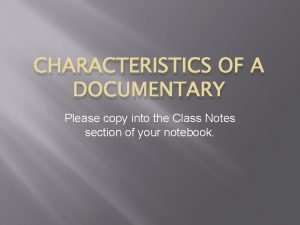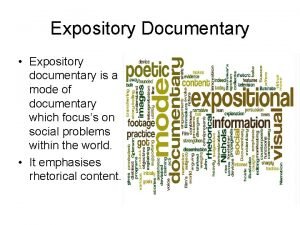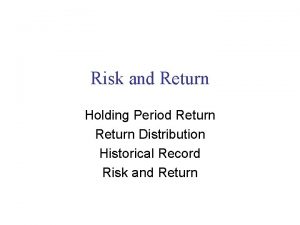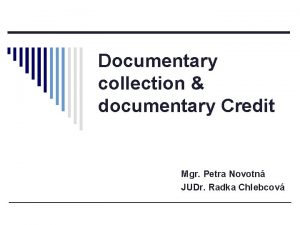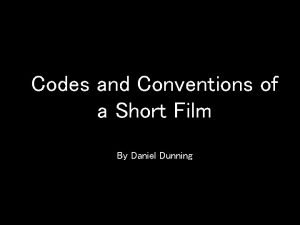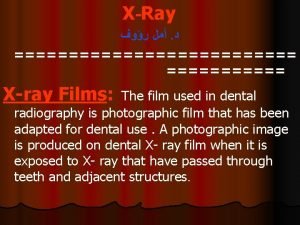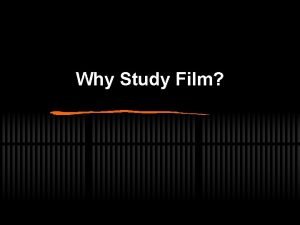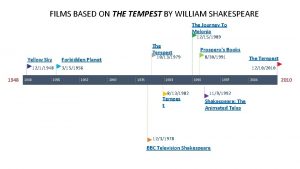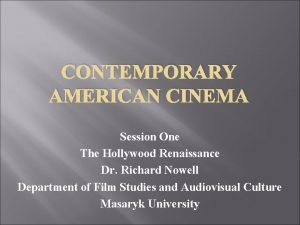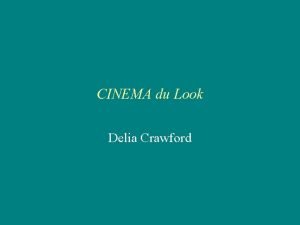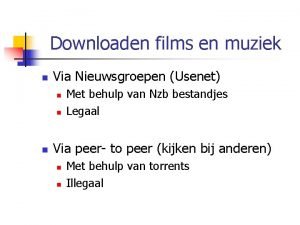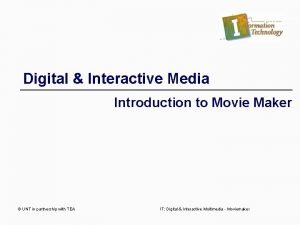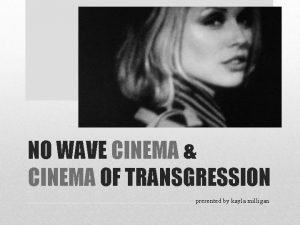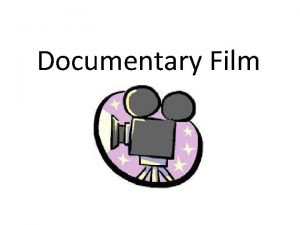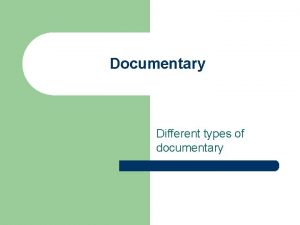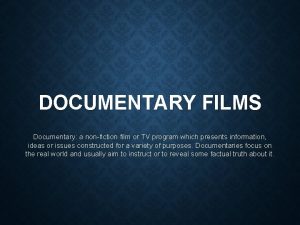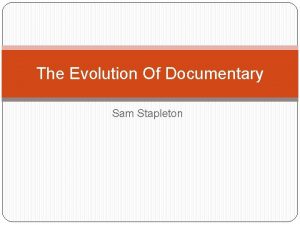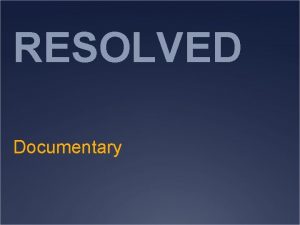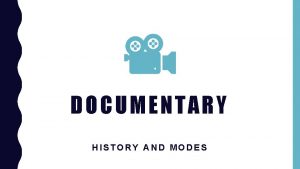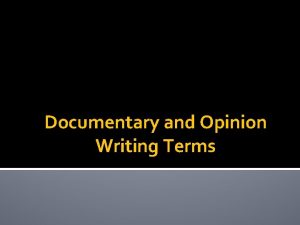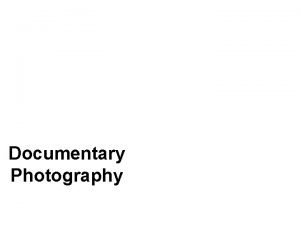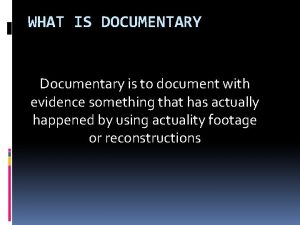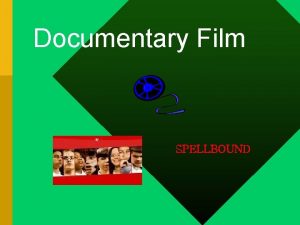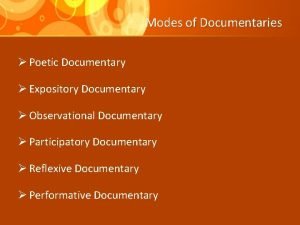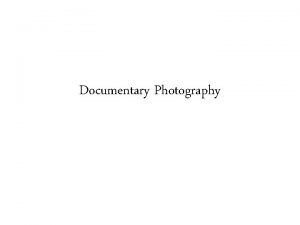The Evolution and Impact of Documentary Films HPR



















- Slides: 19

The Evolution and Impact of Documentary Films HPR 401 Amma Marfo

Table of Contents • Method of Assessment: the Whitehouse Coalition Model • Historical Documentaries – Types of historical documentaries – Techniques to elicit impact – Examples of films • Current Documentaries – Types of current documentaries – Techniques to elicit impact – Examples of films • “Mockumentaries” – Techniques to establish credibility – Examples of films

Method of Assessment: The Whitehouse Coalition Model • Political science professor David Whiteman of the University of South Carolina defined a coalition model to analyze the impact of documentary film: I argue that an adequate model (a) must conceptualize films as part of a larger process that incorporates both production and distribution; (b) must consider the full range of potential impacts on producers, participants, activist organizations, and decision makers; and (c) must consider the role of films in the efforts of social movements to create and sustain alternative spheres of public discourse. (Whiteman, 2004) • This method was used to assess the impact of the films discussed in the paper: how many of the criteria they fit, as well as to what extent they fit.

HISTORICAL DOCUMENTARIES

Types of Historical Documentaries • Foundational Films: simple documentaries, showing real life without actors – Lumiere brothers: showing real life (people leaving a factory, bathing in the sea) – Dziga Vertov: Man with a Movie Camera (1929), detailing life in Russia on a typical day • Led to political documentaries, as Vertov’s film was viewed as propaganda

Types of Historical Documentaries • Propagandistic Films – Man with a Movie Camera (1929): detailed life in Russia, but also showed the political views of Vertov and his support of the 1917 Russian Revolution – Triumph of the Will (1935): Leni Riefenstahl’s allegedly unbiased view at the rise of the Nazi party, which garnered support for the political movement

Types of Historical Documentaries • “Travelogues” – Pioneered largely by Robert Flaherty – Nanook of the North (1922): first actual use of the term ‘documentary’; details the life of the hunting Inuit in Hudson Bay, Canada – Moana (1925): details romantic rituals in the South Seas, giving the viewer insight into life in the South Pacific before Western intervention

Techniques to Elicit Impact • Use of real people • Titles to establish the setting • Establishment of stories to draw the viewer closer to the subject(s) • Even at this early stage, documentaries had a determinate viewpoint

Examples of Films • Triumph of the Will – Riefenstahl was given unprecedented access to the Nazi party, in order to accurately portray their rallies and resulted in an extremely personal view of the Third Reich – Helped to further Riefenstahl’s career immensely – Sustained alternate discourse that resulted in the popularization and support of the Nazi party • Nanook of the North – Production was the result of extensive travel on the part of Flaherty, and controversy was stirred over his staging of given events (the seal hunt) – Participants became spokespeople for the regions they inhabited – Helped to give people a new way to ‘travel, ’ given that it was not that common in the 1920 s to leave home

CURRENT DOCUMENTARIES

Types of Current Documentaries • Political Documentaries: discuss political issues such as – Elections (Unprecedented: The 2000 Election) – Past presidencies (The Fog of War) – Current presidents (Fahrenheit 9/11) • Have these films replaced propaganda?

Types of Current Documentaries • Human Interest Documentaries: they shine light on aspects or subgroups of society that Americans may not otherwise see – Born into Brothels – March of the Penguins – Murderball • In a sense, the human interest documentary has replaced the travelogue

Types of Current Documentaries • Social Change Documentaries: sometimes a hybrid between political and human interest, they tell stories in hopes of changing aspects of society – Jesus Camp – Wal-Mart: The High Cost of Low Price – An Inconvenient Truth • At present, the focus on many of these films is Big Business

Techniques to Elicit Impact • Emotional Appeal: using moving images or stories to touch the emotions of the audience • Empowerment: arousing the spirit of the viewer to stand up and make a difference • Exclusivity: showing aspects of the issue that haven’t previously been seen to garner trust • Familiarity: using images or examples that are familiar to viewers to make them more comfortable • Fear: arousing the terror inside the viewer by showing them the scarier side of issues

Examples of Films • An Inconvenient Truth – The wide distribution of this film has given the issue of global warming and its implications unprecedented exposure – The film has also given Al Gore a new type of image in the public, separate from his roles as Vice-President, and later, serious presidential candidate – The film has started considerable discussion about initiatives to reduce the causes of global warming • Fahrenheit 9/11 – The distribution process was integral in creating the hype and controversy that led to this film’s enormous ticket sales – While some participants have disputed their roles in the film, the major effects were as a result of public policy: the removal of lighters from planes – The film failed to stir the nation to “unseat President Bush” as Moore had hoped, but started discourse about how documentaries should present their information

MOCKUMENTARY FILM (“Mock Documentaries”)

Techniques to Establish Credibility • Archival Photography: the manipulation of photography to be able to tell a story over time, made to appear as though it was taken or filmed in the past • Authoritative Narrator: a voice-over, or the use of title cards, to moderate the flow of the story, as well as to explain more about the story with information that is not in the visual story • Interviews with “Experts”: in order to lend credibility to the information presented, the interviews and testimonials make it seem as though they have studied to learn the information, or were witnesses to something special • “Real” Footage of Events: when footage is designed to appear as though it was taken from security cameras or amateur video, it allows the audience to believe that the story is being told by someone other than the cameraman

Examples of Films • Death of a President – The distribution of the film stirred up controversy in America, because a few cinema chains refused to show it, and media outlets refused to advertise for it – The filmmakers came under fire, even though other films have done before, and they have made films in a similar fashion prior to now – The film created alternate discourse about the nature of mockumentaries as having the potential to discuss dramatic issues as well as comedic ones, as well as whether such inflammatory issues should be discussed on film • Borat: Cultural Learnings for Make Benefit Glorious Nation of Kazakhstan – The production process was controversial in that many people were driven to say things they may not have said, had the film been properly represented – Many participants tried to sue the producers, as well as Sacha Baron Cohen, but found themselves legally barred from doing so; it also heightened the career of the actor who played the sidekick, Azamat – It raised awareness about the prejudices that exist in the country today regarding foreigners and those of various religions

That’s a wrap! Any questions?
 Working title films address
Working title films address Characteristics of documentary
Characteristics of documentary Expository mode definition
Expository mode definition Real return formula
Real return formula Hpr talent
Hpr talent Sightd
Sightd Novotn
Novotn Short film conventions
Short film conventions The purpose of a lead foil sheet in the film packet is
The purpose of a lead foil sheet in the film packet is How to analyze films
How to analyze films Thin films testing
Thin films testing The tempest movies
The tempest movies Readymade films
Readymade films Hollywood renaissance films
Hollywood renaissance films Delia crawford
Delia crawford Bulge test thin films
Bulge test thin films Nieuwsgroepen films downloaden
Nieuwsgroepen films downloaden Interactive movie maker
Interactive movie maker Single camera production films
Single camera production films No wave film
No wave film

